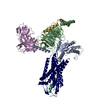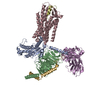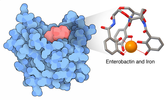+ Open data
Open data
- Basic information
Basic information
| Entry |  | |||||||||
|---|---|---|---|---|---|---|---|---|---|---|
| Title | Cryo-EM structure of endothelin1-bound ETAR-Gq complex | |||||||||
 Map data Map data | ||||||||||
 Sample Sample |
| |||||||||
 Keywords Keywords | ET1 / ETAR / Gq / scFv16 /  MEMBRANE PROTEIN MEMBRANE PROTEIN | |||||||||
| Function / homology |  Function and homology information Function and homology informationregulation of protein localization to cell leading edge / : /  endothelin receptor activity / positive regulation of prostaglandin-endoperoxide synthase activity / endothelin receptor activity / positive regulation of prostaglandin-endoperoxide synthase activity /  endothelin A receptor binding / protein kinase C deactivation / cellular response to human chorionic gonadotropin stimulus / meiotic cell cycle process involved in oocyte maturation / phospholipase D-activating G protein-coupled receptor signaling pathway / endothelin A receptor binding / protein kinase C deactivation / cellular response to human chorionic gonadotropin stimulus / meiotic cell cycle process involved in oocyte maturation / phospholipase D-activating G protein-coupled receptor signaling pathway /  endothelin B receptor binding ...regulation of protein localization to cell leading edge / : / endothelin B receptor binding ...regulation of protein localization to cell leading edge / : /  endothelin receptor activity / positive regulation of prostaglandin-endoperoxide synthase activity / endothelin receptor activity / positive regulation of prostaglandin-endoperoxide synthase activity /  endothelin A receptor binding / protein kinase C deactivation / cellular response to human chorionic gonadotropin stimulus / meiotic cell cycle process involved in oocyte maturation / phospholipase D-activating G protein-coupled receptor signaling pathway / endothelin A receptor binding / protein kinase C deactivation / cellular response to human chorionic gonadotropin stimulus / meiotic cell cycle process involved in oocyte maturation / phospholipase D-activating G protein-coupled receptor signaling pathway /  endothelin B receptor binding / rhythmic excitation / peptide hormone secretion / neural crest cell fate commitment / sympathetic neuron axon guidance / endothelin B receptor binding / rhythmic excitation / peptide hormone secretion / neural crest cell fate commitment / sympathetic neuron axon guidance /  Oplophorus-luciferin 2-monooxygenase / body fluid secretion / Oplophorus-luciferin 2-monooxygenase / body fluid secretion /  Oplophorus-luciferin 2-monooxygenase activity / glomerular endothelium development / vein smooth muscle contraction / noradrenergic neuron differentiation / response to prostaglandin F / positive regulation of renal sodium excretion / leukocyte activation / positive regulation of sarcomere organization / vascular associated smooth muscle cell development / atrial cardiac muscle tissue development / histamine secretion / heparin metabolic process / rough endoplasmic reticulum lumen / positive regulation of chemokine-mediated signaling pathway / positive regulation of odontogenesis / maternal process involved in parturition / cardiac chamber formation / pharyngeal arch artery morphogenesis / regulation of glucose transmembrane transport / endothelin receptor signaling pathway involved in heart process / semaphorin-plexin signaling pathway involved in axon guidance / epithelial fluid transport / podocyte differentiation / cardiac neural crest cell migration involved in outflow tract morphogenesis / negative regulation of hormone secretion / protein transmembrane transport / response to leptin / endothelin receptor signaling pathway / response to ozone / sodium ion homeostasis / Oplophorus-luciferin 2-monooxygenase activity / glomerular endothelium development / vein smooth muscle contraction / noradrenergic neuron differentiation / response to prostaglandin F / positive regulation of renal sodium excretion / leukocyte activation / positive regulation of sarcomere organization / vascular associated smooth muscle cell development / atrial cardiac muscle tissue development / histamine secretion / heparin metabolic process / rough endoplasmic reticulum lumen / positive regulation of chemokine-mediated signaling pathway / positive regulation of odontogenesis / maternal process involved in parturition / cardiac chamber formation / pharyngeal arch artery morphogenesis / regulation of glucose transmembrane transport / endothelin receptor signaling pathway involved in heart process / semaphorin-plexin signaling pathway involved in axon guidance / epithelial fluid transport / podocyte differentiation / cardiac neural crest cell migration involved in outflow tract morphogenesis / negative regulation of hormone secretion / protein transmembrane transport / response to leptin / endothelin receptor signaling pathway / response to ozone / sodium ion homeostasis /  Weibel-Palade body / developmental pigmentation / response to acetylcholine / renal sodium ion absorption / positive regulation of cell growth involved in cardiac muscle cell development / mesenchymal cell apoptotic process / Weibel-Palade body / developmental pigmentation / response to acetylcholine / renal sodium ion absorption / positive regulation of cell growth involved in cardiac muscle cell development / mesenchymal cell apoptotic process /  glomerular filtration / artery smooth muscle contraction / podocyte apoptotic process / left ventricular cardiac muscle tissue morphogenesis / embryonic skeletal system development / axonogenesis involved in innervation / glomerular filtration / artery smooth muscle contraction / podocyte apoptotic process / left ventricular cardiac muscle tissue morphogenesis / embryonic skeletal system development / axonogenesis involved in innervation /  enteric nervous system development / positive regulation of cation channel activity / positive regulation of prostaglandin secretion / renal albumin absorption / cellular response to follicle-stimulating hormone stimulus / cellular response to luteinizing hormone stimulus / cranial skeletal system development / regulation of pH / negative regulation of nitric-oxide synthase biosynthetic process / cellular response to mineralocorticoid stimulus / positive regulation of urine volume / respiratory gaseous exchange by respiratory system / basal part of cell / positive regulation of smooth muscle contraction / enteric nervous system development / positive regulation of cation channel activity / positive regulation of prostaglandin secretion / renal albumin absorption / cellular response to follicle-stimulating hormone stimulus / cellular response to luteinizing hormone stimulus / cranial skeletal system development / regulation of pH / negative regulation of nitric-oxide synthase biosynthetic process / cellular response to mineralocorticoid stimulus / positive regulation of urine volume / respiratory gaseous exchange by respiratory system / basal part of cell / positive regulation of smooth muscle contraction /  sympathetic nervous system development / phosphatidylinositol phospholipase C activity / norepinephrine metabolic process / positive regulation of hormone secretion / regulation of systemic arterial blood pressure by endothelin / sympathetic nervous system development / phosphatidylinositol phospholipase C activity / norepinephrine metabolic process / positive regulation of hormone secretion / regulation of systemic arterial blood pressure by endothelin /  vasoconstriction / protein kinase C-activating G protein-coupled receptor signaling pathway / embryonic heart tube development / negative regulation of blood coagulation / axon extension / superoxide anion generation / dorsal/ventral pattern formation / establishment of endothelial barrier / positive regulation of neutrophil chemotaxis / middle ear morphogenesis / positive regulation of signaling receptor activity / cellular response to glucocorticoid stimulus / cartilage development / aorta development / prostaglandin biosynthetic process / neuromuscular process / negative regulation of protein metabolic process / nitric oxide transport / cellular response to fatty acid / neuron remodeling / cellular response to organic substance / branching involved in blood vessel morphogenesis / positive regulation of heart rate vasoconstriction / protein kinase C-activating G protein-coupled receptor signaling pathway / embryonic heart tube development / negative regulation of blood coagulation / axon extension / superoxide anion generation / dorsal/ventral pattern formation / establishment of endothelial barrier / positive regulation of neutrophil chemotaxis / middle ear morphogenesis / positive regulation of signaling receptor activity / cellular response to glucocorticoid stimulus / cartilage development / aorta development / prostaglandin biosynthetic process / neuromuscular process / negative regulation of protein metabolic process / nitric oxide transport / cellular response to fatty acid / neuron remodeling / cellular response to organic substance / branching involved in blood vessel morphogenesis / positive regulation of heart rateSimilarity search - Function | |||||||||
| Biological species |   Homo (humans) / Homo (humans) /   Homo sapiens (human) / Homo sapiens (human) /   Mus musculus (house mouse) Mus musculus (house mouse) | |||||||||
| Method |  single particle reconstruction / single particle reconstruction /  cryo EM / Resolution: 3.01 Å cryo EM / Resolution: 3.01 Å | |||||||||
 Authors Authors | Yuan Q / Jiang Y / Xu HE / Ji Y / Duan J | |||||||||
| Funding support |  China, 1 items China, 1 items
| |||||||||
 Citation Citation |  Journal: Nat Commun / Year: 2023 Journal: Nat Commun / Year: 2023Title: Structural basis of peptide recognition and activation of endothelin receptors. Authors: Yujie Ji / Jia Duan / Qingning Yuan / Xinheng He / Gong Yang / Shengnan Zhu / Kai Wu / Wen Hu / Tianyu Gao / Xi Cheng / Hualiang Jiang / H Eric Xu / Yi Jiang /  Abstract: Endothelin system comprises three endogenous 21-amino-acid peptide ligands endothelin-1, -2, and -3 (ET-1/2/3), and two G protein-coupled receptor (GPCR) subtypes-endothelin receptor A (ETR) and B ...Endothelin system comprises three endogenous 21-amino-acid peptide ligands endothelin-1, -2, and -3 (ET-1/2/3), and two G protein-coupled receptor (GPCR) subtypes-endothelin receptor A (ETR) and B (ETR). Since ET-1, the first endothelin, was identified in 1988 as one of the most potent endothelial cell-derived vasoconstrictor peptides with long-lasting actions, the endothelin system has attracted extensive attention due to its critical role in vasoregulation and close relevance in cardiovascular-related diseases. Here we present three cryo-electron microscopy structures of ETR and ETR bound to ET-1 and ETR bound to the selective peptide IRL1620. These structures reveal a highly conserved recognition mode of ET-1 and characterize the ligand selectivity by ETRs. They also present several conformation features of the active ETRs, thus revealing a specific activation mechanism. Together, these findings deepen our understanding of endothelin system regulation and offer an opportunity to design selective drugs targeting specific ETR subtypes. | |||||||||
| History |
|
- Structure visualization
Structure visualization
| Supplemental images |
|---|
- Downloads & links
Downloads & links
-EMDB archive
| Map data |  emd_34663.map.gz emd_34663.map.gz | 56.6 MB |  EMDB map data format EMDB map data format | |
|---|---|---|---|---|
| Header (meta data) |  emd-34663-v30.xml emd-34663-v30.xml emd-34663.xml emd-34663.xml | 20 KB 20 KB | Display Display |  EMDB header EMDB header |
| Images |  emd_34663.png emd_34663.png | 37.6 KB | ||
| Filedesc metadata |  emd-34663.cif.gz emd-34663.cif.gz | 6.6 KB | ||
| Others |  emd_34663_half_map_1.map.gz emd_34663_half_map_1.map.gz emd_34663_half_map_2.map.gz emd_34663_half_map_2.map.gz | 49.6 MB 49.4 MB | ||
| Archive directory |  http://ftp.pdbj.org/pub/emdb/structures/EMD-34663 http://ftp.pdbj.org/pub/emdb/structures/EMD-34663 ftp://ftp.pdbj.org/pub/emdb/structures/EMD-34663 ftp://ftp.pdbj.org/pub/emdb/structures/EMD-34663 | HTTPS FTP |
-Related structure data
| Related structure data |  8hcqMC  8hbdC  8hcxC M: atomic model generated by this map C: citing same article ( |
|---|---|
| Similar structure data | Similarity search - Function & homology  F&H Search F&H Search |
- Links
Links
| EMDB pages |  EMDB (EBI/PDBe) / EMDB (EBI/PDBe) /  EMDataResource EMDataResource |
|---|---|
| Related items in Molecule of the Month |
- Map
Map
| File |  Download / File: emd_34663.map.gz / Format: CCP4 / Size: 64 MB / Type: IMAGE STORED AS FLOATING POINT NUMBER (4 BYTES) Download / File: emd_34663.map.gz / Format: CCP4 / Size: 64 MB / Type: IMAGE STORED AS FLOATING POINT NUMBER (4 BYTES) | ||||||||||||||||||||
|---|---|---|---|---|---|---|---|---|---|---|---|---|---|---|---|---|---|---|---|---|---|
| Voxel size | X=Y=Z: 0.824 Å | ||||||||||||||||||||
| Density |
| ||||||||||||||||||||
| Symmetry | Space group: 1 | ||||||||||||||||||||
| Details | EMDB XML:
|
-Supplemental data
-Half map: #2
| File | emd_34663_half_map_1.map | ||||||||||||
|---|---|---|---|---|---|---|---|---|---|---|---|---|---|
| Projections & Slices |
| ||||||||||||
| Density Histograms |
-Half map: #1
| File | emd_34663_half_map_2.map | ||||||||||||
|---|---|---|---|---|---|---|---|---|---|---|---|---|---|
| Projections & Slices |
| ||||||||||||
| Density Histograms |
- Sample components
Sample components
-Entire : ET1-ETAR-Gq-scFv16 complex
| Entire | Name: ET1-ETAR-Gq-scFv16 complex |
|---|---|
| Components |
|
-Supramolecule #1: ET1-ETAR-Gq-scFv16 complex
| Supramolecule | Name: ET1-ETAR-Gq-scFv16 complex / type: complex / ID: 1 / Parent: 0 / Macromolecule list: #6, #5, #1-#4 |
|---|---|
| Source (natural) | Organism:   Homo (humans) Homo (humans) |
-Macromolecule #1: Guanine nucleotide-binding protein G(q) subunit alpha-1
| Macromolecule | Name: Guanine nucleotide-binding protein G(q) subunit alpha-1 type: protein_or_peptide / ID: 1 / Number of copies: 1 / Enantiomer: LEVO |
|---|---|
| Source (natural) | Organism:   Homo sapiens (human) Homo sapiens (human) |
| Molecular weight | Theoretical: 28.084832 KDa |
| Recombinant expression | Organism:   Spodoptera frugiperda (fall armyworm) Spodoptera frugiperda (fall armyworm) |
| Sequence | String: MGSTVSAEDK AAAERSKMID KNLREDGEKA RRTLRLLLLG ADNSGKSTIV KQMRILHGGS GGSGGTSGIF ETKFQVDKVN FHMFDVGGQ RDERRKWIQC FNDVTAIIFV VDSSDYNRLQ EALNDFKSIW NNRWLRTISV ILFLNKQDLL AEKVLAGKSK I EDYFPEFA ...String: MGSTVSAEDK AAAERSKMID KNLREDGEKA RRTLRLLLLG ADNSGKSTIV KQMRILHGGS GGSGGTSGIF ETKFQVDKVN FHMFDVGGQ RDERRKWIQC FNDVTAIIFV VDSSDYNRLQ EALNDFKSIW NNRWLRTISV ILFLNKQDLL AEKVLAGKSK I EDYFPEFA RYTTPEDATP EPGEDPRVTR AKYFIRKEFV DISTASGDGR HICYPHFTCA VDTENARRIF NDCKDIILQM NL REYNLV |
-Macromolecule #2: Guanine nucleotide-binding protein G(I)/G(S)/G(T) subunit beta-1
| Macromolecule | Name: Guanine nucleotide-binding protein G(I)/G(S)/G(T) subunit beta-1 type: protein_or_peptide / ID: 2 / Number of copies: 1 / Enantiomer: LEVO |
|---|---|
| Source (natural) | Organism:   Homo sapiens (human) Homo sapiens (human) |
| Molecular weight | Theoretical: 41.055867 KDa |
| Recombinant expression | Organism:   Spodoptera frugiperda (fall armyworm) Spodoptera frugiperda (fall armyworm) |
| Sequence | String: MHHHHHHGSL LQSELDQLRQ EAEQLKNQIR DARKACADAT LSQITNNIDP VGRIQMRTRR TLRGHLAKIY AMHWGTDSRL LVSASQDGK LIIWDSYTTN KVHAIPLRSS WVMTCAYAPS GNYVACGGLD NICSIYNLKT REGNVRVSRE LAGHTGYLSC C RFLDDNQI ...String: MHHHHHHGSL LQSELDQLRQ EAEQLKNQIR DARKACADAT LSQITNNIDP VGRIQMRTRR TLRGHLAKIY AMHWGTDSRL LVSASQDGK LIIWDSYTTN KVHAIPLRSS WVMTCAYAPS GNYVACGGLD NICSIYNLKT REGNVRVSRE LAGHTGYLSC C RFLDDNQI VTSSGDTTCA LWDIETGQQT TTFTGHTGDV MSLSLAPDTR LFVSGACDAS AKLWDVREGM CRQTFTGHES DI NAICFFP NGNAFATGSD DATCRLFDLR ADQELMTYSH DNIICGITSV SFSKSGRLLL AGYDDFNCNV WDALKADRAG VLA GHDNRV SCLGVTDDGM AVATGSWDSF LKIWNGSSGG GGSGGGGSSG VSGWRLFKKI S UniProtKB: Guanine nucleotide-binding protein G(I)/G(S)/G(T) subunit beta-1 |
-Macromolecule #3: scFv16
| Macromolecule | Name: scFv16 / type: protein_or_peptide / ID: 3 / Number of copies: 1 / Enantiomer: LEVO |
|---|---|
| Source (natural) | Organism:   Mus musculus (house mouse) Mus musculus (house mouse) |
| Molecular weight | Theoretical: 30.363043 KDa |
| Recombinant expression | Organism:   Spodoptera frugiperda (fall armyworm) Spodoptera frugiperda (fall armyworm) |
| Sequence | String: MLLVNQSHQG FNKEHTSKMV SAIVLYVLLA AAAHSAFAVQ LVESGGGLVQ PGGSRKLSCS ASGFAFSSFG MHWVRQAPEK GLEWVAYIS SGSGTIYYAD TVKGRFTISR DDPKNTLFLQ MTSLRSEDTA MYYCVRSIYY YGSSPFDFWG QGTTLTVSAG G GGSGGGGS ...String: MLLVNQSHQG FNKEHTSKMV SAIVLYVLLA AAAHSAFAVQ LVESGGGLVQ PGGSRKLSCS ASGFAFSSFG MHWVRQAPEK GLEWVAYIS SGSGTIYYAD TVKGRFTISR DDPKNTLFLQ MTSLRSEDTA MYYCVRSIYY YGSSPFDFWG QGTTLTVSAG G GGSGGGGS GGGGSADIVM TQATSSVPVT PGESVSISCR SSKSLLHSNG NTYLYWFLQR PGQSPQLLIY RMSNLASGVP DR FSGSGSG TAFTLTISRL EAEDVGVYYC MQHLEYPLTF GAGTKLEL |
-Macromolecule #4: Guanine nucleotide-binding protein G(I)/G(S)/G(O) subunit gamma-2
| Macromolecule | Name: Guanine nucleotide-binding protein G(I)/G(S)/G(O) subunit gamma-2 type: protein_or_peptide / ID: 4 / Number of copies: 1 / Enantiomer: LEVO |
|---|---|
| Source (natural) | Organism:   Homo sapiens (human) Homo sapiens (human) |
| Molecular weight | Theoretical: 7.861143 KDa |
| Recombinant expression | Organism:   Spodoptera frugiperda (fall armyworm) Spodoptera frugiperda (fall armyworm) |
| Sequence | String: MASNNTASIA QARKLVEQLK MEANIDRIKV SKAAADLMAY CEAHAKEDPL LTPVPASENP FREKKFFCAI L UniProtKB: Guanine nucleotide-binding protein G(I)/G(S)/G(O) subunit gamma-2 |
-Macromolecule #5: Endothelin-1
| Macromolecule | Name: Endothelin-1 / type: protein_or_peptide / ID: 5 / Number of copies: 1 / Enantiomer: LEVO |
|---|---|
| Source (natural) | Organism:   Homo sapiens (human) Homo sapiens (human) |
| Molecular weight | Theoretical: 2.497951 KDa |
| Recombinant expression | Organism:   Spodoptera frugiperda (fall armyworm) Spodoptera frugiperda (fall armyworm) |
| Sequence | String: CSCSSLMDKE CVYFCHLDII W UniProtKB:  Endothelin-1 Endothelin-1 |
-Macromolecule #6: Endothelin-1 receptor,Oplophorus-luciferin 2-monooxygenase cataly...
| Macromolecule | Name: Endothelin-1 receptor,Oplophorus-luciferin 2-monooxygenase catalytic subunit chimera type: protein_or_peptide / ID: 6 / Number of copies: 1 / Enantiomer: LEVO / EC number:  Oplophorus-luciferin 2-monooxygenase Oplophorus-luciferin 2-monooxygenase |
|---|---|
| Source (natural) | Organism:   Homo sapiens (human) Homo sapiens (human) |
| Molecular weight | Theoretical: 69.969906 KDa |
| Recombinant expression | Organism:   Spodoptera frugiperda (fall armyworm) Spodoptera frugiperda (fall armyworm) |
| Sequence | String: MDSKGSSQKG SRLLLLLVVS NLLLCQGVVS DYKDDDDVDM GQPGNGSAFL LAPNGSHAPD HDVTQQRDEE NLYFQGASDN PERYSTNLS NHVDDFTTFR GTELSFLVTT HQPTNLVLPS NGSMHNYCPQ QTKITSAFKY INTVISCTIF IVGMVGNATL L RIIYQNKC ...String: MDSKGSSQKG SRLLLLLVVS NLLLCQGVVS DYKDDDDVDM GQPGNGSAFL LAPNGSHAPD HDVTQQRDEE NLYFQGASDN PERYSTNLS NHVDDFTTFR GTELSFLVTT HQPTNLVLPS NGSMHNYCPQ QTKITSAFKY INTVISCTIF IVGMVGNATL L RIIYQNKC MRNGPNALIA SLALGDLIYV VIDLPINVFK LLAGRWPFDH NDFGVFLCKL FPFLQKSSVG ITVLNLCALS VD RYRAVAS WSRVQGIGIP LVTAIEIVSI WILSFILAIP EAIGFVMVPF EYRGEQHKTC MLNATSKFME FYQDVKDWWL FGF YFCMPL VCTAIFYTLM TCEMLNRRNG SLRIALSEHL KQRREVAKTV FCLVVIFALC WFPLHLSRIL KKTVYNEMDK NRCE LLSFL LLMDYIGINL ATMNSCINPI ALYFVSKKFK NCFQSCLCCC CYQSKSLMTS VPMNGTSIQV FTLEDFVGDW EQTAA YNLD QVLEQGGVSS LLQNLAVSVT PIQRIVRSGE NALKIDIHVI IPYEGLSADQ MAQIEEVFKV VYPVDDHHFK VILPYG TLV IDGVTPNMLN YFGRPYEGIA VFDGKKITVT GTLWNGNKII DERLITPDGS MLFRVTINS UniProtKB: Endothelin-1 receptor, Oplophorus-luciferin 2-monooxygenase catalytic subunit |
-Experimental details
-Structure determination
| Method |  cryo EM cryo EM |
|---|---|
 Processing Processing |  single particle reconstruction single particle reconstruction |
| Aggregation state | particle |
- Sample preparation
Sample preparation
| Buffer | pH: 7.4 |
|---|---|
| Vitrification | Cryogen name: ETHANE |
- Electron microscopy
Electron microscopy
| Microscope | FEI TITAN KRIOS |
|---|---|
| Electron beam | Acceleration voltage: 300 kV / Electron source:  FIELD EMISSION GUN FIELD EMISSION GUN |
| Electron optics | Illumination mode: FLOOD BEAM / Imaging mode: BRIGHT FIELD Bright-field microscopy / Nominal defocus max: 1.8 µm / Nominal defocus min: 0.8 µm Bright-field microscopy / Nominal defocus max: 1.8 µm / Nominal defocus min: 0.8 µm |
| Image recording | Film or detector model: GATAN K3 BIOQUANTUM (6k x 4k) / Average electron dose: 50.0 e/Å2 |
| Experimental equipment |  Model: Titan Krios / Image courtesy: FEI Company |
- Image processing
Image processing
| Startup model | Type of model: OTHER |
|---|---|
| Initial angle assignment | Type: MAXIMUM LIKELIHOOD |
| Final angle assignment | Type: MAXIMUM LIKELIHOOD |
| Final reconstruction | Resolution.type: BY AUTHOR / Resolution: 3.01 Å / Resolution method: FSC 0.143 CUT-OFF / Number images used: 510197 |
 Movie
Movie Controller
Controller































 Z
Z Y
Y X
X

















